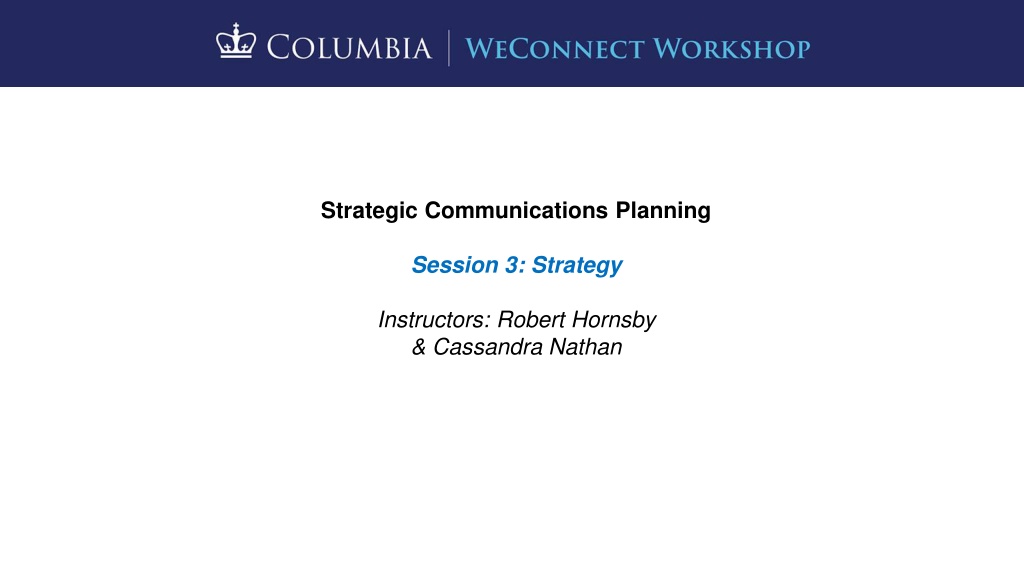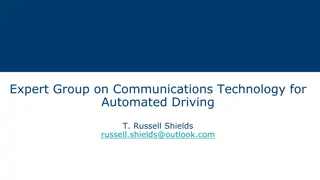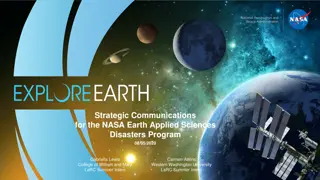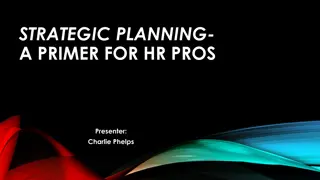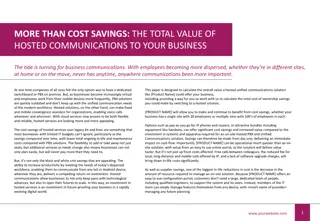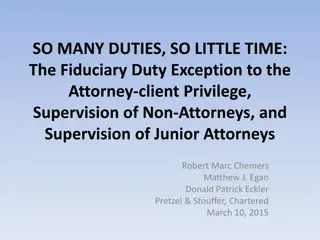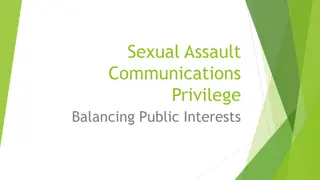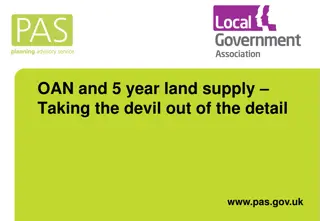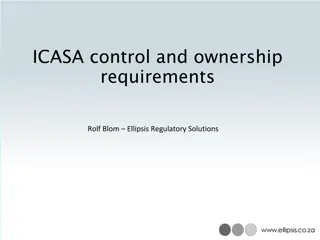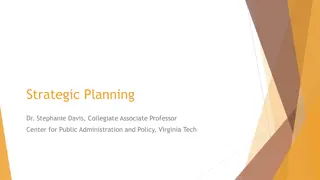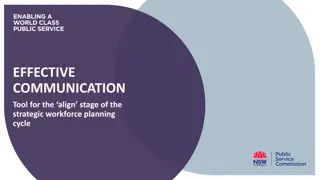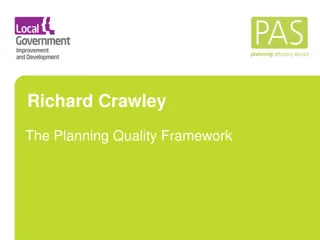Understanding Strategic Communications Planning
This content delves into the intricacies of strategic communications planning, covering topics such as defining communication goals, elements of a communications plan, and the importance of strategy in various arenas. The importance of strategy in connecting purpose, audience, and outcomes is emphasized, along with the characteristics and analogies illustrating the role of strategy in achieving goals effectively.
Download Presentation

Please find below an Image/Link to download the presentation.
The content on the website is provided AS IS for your information and personal use only. It may not be sold, licensed, or shared on other websites without obtaining consent from the author. Download presentation by click this link. If you encounter any issues during the download, it is possible that the publisher has removed the file from their server.
E N D
Presentation Transcript
Strategic Communications Planning Session 3: Strategy Instructors: Robert Hornsby & Cassandra Nathan
Review of session 2 Comms Goals: How did it go? What was easiest piece to define or explain? What was the hardest piece to define or explain?
Refresher: Elements of a Communications Plan Situation Analysis Goals the WHY Strategy the WHAT Tactics the HOW Metrics Evaluation 1. 2. 3. 4. 5. 6.
Strategy defined: Name a few arenas where most people agree that strategy is important. What do we call those strategies, and why is strategy important in that arena?
Strategy defined: Name a few arenas where most people agree that strategy is important. What do we call those strategies, and why is strategy important in that arena? o Sports = Game plan o Military = Battle plan o Business = Marketing plan o Politics = Campaign o Architecture = Blueprint o Other?
Why is Strategy important? Strategy is the demonstration of PURPOSE. Strategy connects AUDIENCE and OUTCOMES.
Strategy defined: Strategy is an approach, a plan of action or a set of policies designed to achieve a goal. Strategy is the path to a goal. Strategy is a plan about what to do. Tactics are production, making your strategy tangible the making or doing -- actions, deliverables, products.
Strategy defined: Characteristics of Strategy what strategy does: Defines the purpose of your communications. Delivers your value proposition. Ensures alignment between goals, plans and actions. Use the Strategy section of your plan to organize your tactics.
Strategy defined -- an analogy: Institutional Goal: We want to live in a house. Operational goal: Buy or build a house. Strategy: Research both choices; evaluate finances, locations, delay to occupancy, etc. Make a decision, arrange implementation. Tactics: Hire architect to design, hire contractor(s) to build the house; begin building. Metrics: Monitor contractor progress & expenses. Reporting: Notify your family and friends about project milestones and move-in date.
Strategy defined: Interplay between goals, strategy and tactics a simplified example: Comms Goal: Establish my organization and its leaders as thought leaders/influencers in their discipline.
Strategy defined: Interplay between goals, strategy and tactics a simplified example: Comms Goal: Establish my organization and its leaders as thought leaders/influencers in their discipline. Strategy: Demonstrate the expertise and critical thinking of my organization and its leaders. Target audiences: academic and industry peers and potential students. Key message: (My organization) has some of the best and brightest thinkers in (my industry, discipline or field of study).
Strategy defined: Interplay between goals, strategy and tactics a simplified example: Comms Goal: Establish my organization and its leaders as thought leaders/influencers in their discipline. Strategy: Demonstrate the expertise and critical thinking of my organization and its leaders. Target audiences: academic and industry peers and potential students. Key message: (My organization) has some of the best and brightest thinkers in (my industry, discipline or field of study). Tactics: Publish opinion editorials for academic outlets and trade press. Offer experts to comment about current events as they occur to academic bloggers, trade press, mainstream press and social media. Produce a provocative conference for a target audience and the press.
Sample strategy statements: (be more specific in your plan) Promote our services and/or opportunities to target audiences (who?) Exhibit our thought leadership (about what?) Showcase our expertise (in what subjects? To whom?) Highlight success stories Demonstrate our [school, dept, unit s] relevance to current events and ideas
About Strategy & Tactics: As you think about strategy, you will naturally think about tactics. Tactics are the key tasks, actions or collateral for executing your Comms strategy. As you work on your plan, record tasks and park those on a tactics worksheet.
About Strategy & Tactics: As you think about strategy, you will naturally think about tactics. Tactics are the key tasks, actions or collateral for executing your Comms strategy. As you work on your plan, record tasks and park those on a tactics worksheet. DIRTY SECRET: You can reverse engineer strategy by analyzing tactics. But how? Return to Audience / Purpose / Outcomes What are the audiences of various tactics you already deploy? Why is a particular tactic in favor or considered effective? What does a particular tactic deliver? Are there links between content and tactics?
Strategy: Key Messages* Declarative statements that help define your strategy and service your goals. Key messages contain the main ideas you want your audience to understand and remember. Succinct summations that articulate: What you do Why you do it How you are different What value you bring to stakeholders o o o o *credit: Model Systems Knowledge Translation Center (MSKTC)
More about key messages: Key messages clarify meaning and provide the takeaway headline of the issue you want to communicate. Key messages serve as the foundation of an organization s branding and marketing efforts and should be reflected in all written and spoken communications. They help you to: Prioritize and define information; Ensure consistency, continuity and accuracy; Measure and track success; and Stay focused when speaking with stakeholders and the press. o o o o
Attributes of key messages: Concise: Maximum 3 key messages per page; each statement only 1-3 sentences long or under 30 seconds when spoken. Meaningful: Define, differentiate and align with benefits/value proposition. Relevant: Balance what you need to communicate with what your audience needs to know. Compelling: Meaningful information designed to stimulate action. Simple: Easy-to-understand language; minimal jargon and acronyms. Memorable: Easy to recall and repeat; avoid run-on sentences. Relatable: Active rather than passive voice; no advertising slogans. Tailored: Adaptable to different target audiences, with flexible language and depth of information
Strategy discussion questions: 1. Do you already have a Comms strategy? If not, could you devise one from what you already know? 2. Do you need to communicate with new or different audiences that before? 3. Does your organization need or want something different from existing audiences or new audiences, i.e. a different outcome? 4. Will you need different strategies to reach, educate or persuade different audiences? 5. Do you have to do more or reorient your tactics or resources to achieve our Comms goals?
Communications Strategy: Breakout Situation of the Day : Your dean or department leader calls you up, Hello, I was just in a meeting with other deans, and one of them talked about her media strategy. You re in communications -- do we have one? Can you help? Go. What is your first question(s) for the dean? Then: Pick one of the Comms Goals of any class member. Define 1 strategy to achieve that goal. (Make sure it s not a tactic.)
Communications Strategy: Breakout review Homework: Make substantive comments on Communication Goals drafts by your teammates 1-page (minimum) Strategy due next Thursday
Supplement: Communications Matrix tool (saved in class folders)
